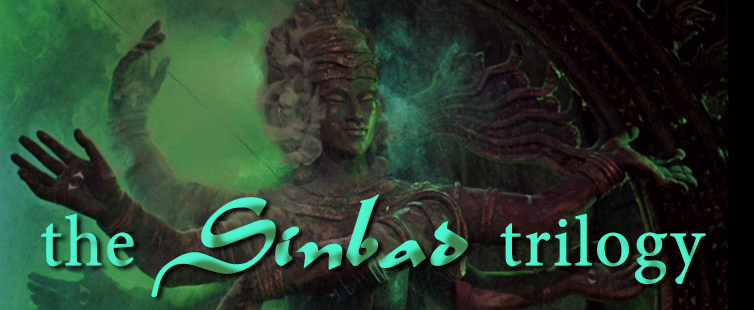
7TH VOYAGE OF SINBAD THE GOLDEN VOYAGE OF SINBAD SINBAD AND THE EYE OF THE TIGER
Color, 1958, 88 mins. 7 secs.
Directed by Nathan Juran
Starring Kerwin Mathews, Kathryn Grant, Richard Eyer, Torin Thatcher, Alec Mango
Indicator (Blu-ray & DVD) (UK R0 HD/PAL), Sony (Blu-ray & DVD) (US R0 HD/NTSC) / WS (1.66:1) (16:9)
Color, 1973, 104 mins. 59 secs.
Directed by Gordon Hessler
Starring John Phillip Law, Caroline Munro, Tom Baker, Douglas Wilmer, Martin Shaw
Indicator (Blu-ray & DVD) (UK R0 HD/PAL), Twilight Time (Blu-ray) (US R0 HD), Sony (DVD) (US R0 NTSC) / WS (1.66:1) (16:9)
Color, 1977, 112 mins. 59 secs.
Directed by Sam Wanamaker
Starring Patrick Wayne, Jane Seymour, Taryn Power, Margaret Whiting, Patrick Troughton
Indicator (Blu-ray & DVD) (UK R0 HD/PAL), Twilight Time (Blu-ray) (US R0 HD), Sony (DVD) (US R0 NTSC) / WS (1.85:1) (16:9)
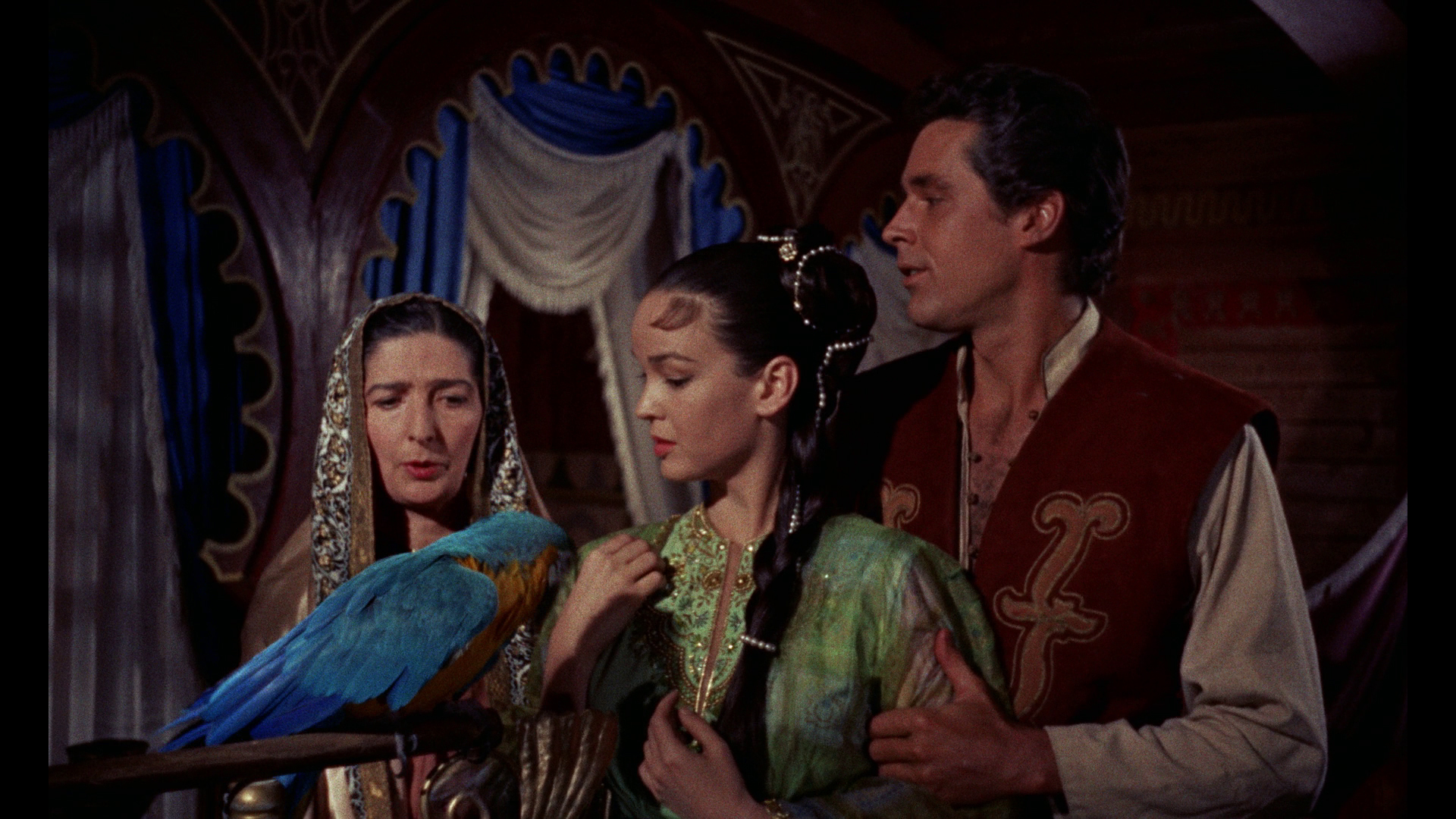
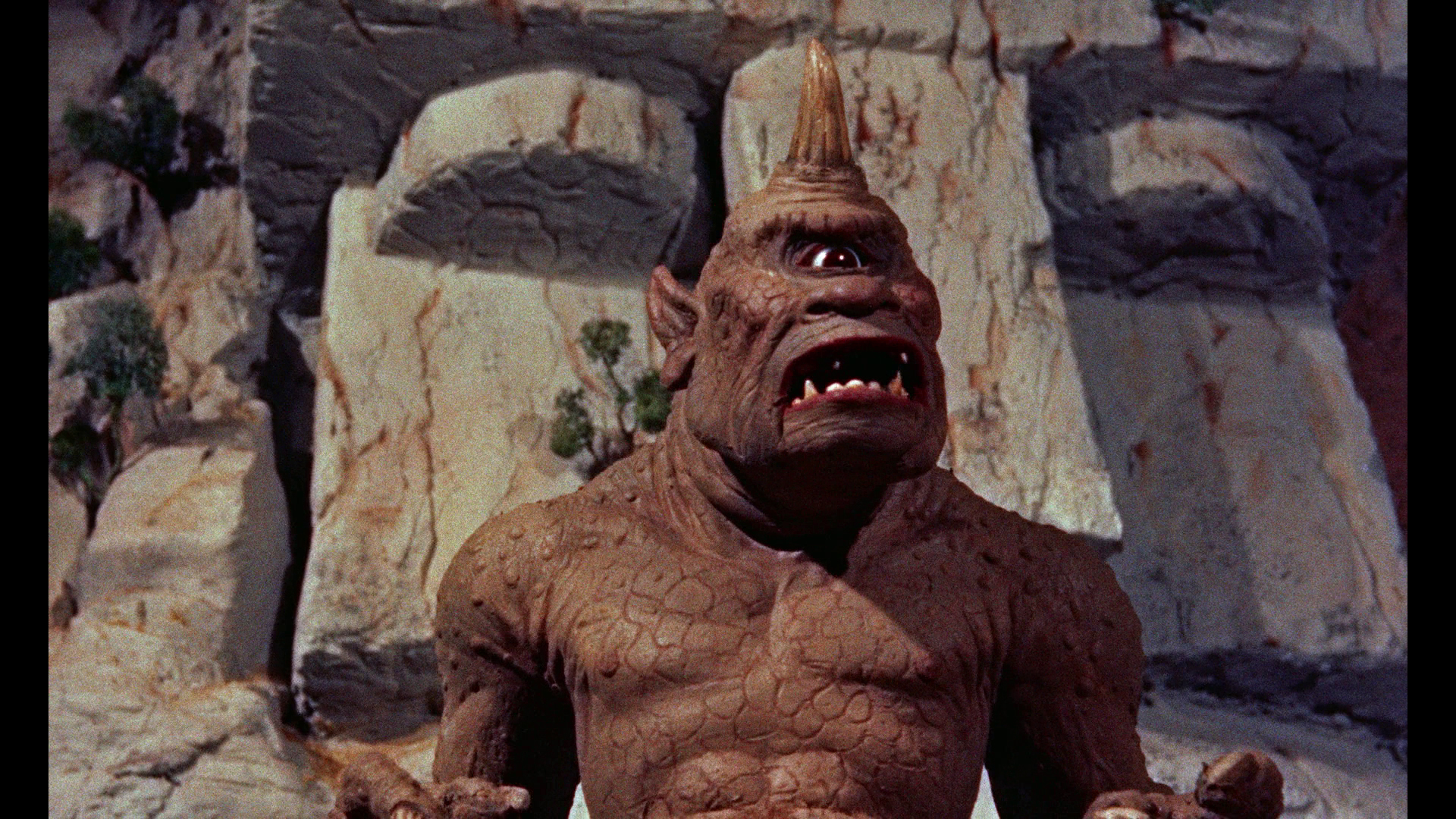 The definitive Saturday matinee movie, The 7th Voyage of Sinbad inspired waves of impressionable little kids to go into the special effects business and made Ray Harryhausen a cinematic god for fantasy fans. A pioneer in the art of stop motion animation, Harryhausen had already made an impression with his black and white sci-fi spectacles like 20 Million Miles to Earth and It Came from Beneath the Sea. However, Sinbad offered the first time his effects could be seen in vivid color, and even better, Harryhausen provided a whole slew of imaginative creatures, rather than one simple octopus or alien. Sinbad proved so popular that Harryhausen remained busy doing other fantastic literary adaptations and two more highly enjoyable Sinbad adventures.
The definitive Saturday matinee movie, The 7th Voyage of Sinbad inspired waves of impressionable little kids to go into the special effects business and made Ray Harryhausen a cinematic god for fantasy fans. A pioneer in the art of stop motion animation, Harryhausen had already made an impression with his black and white sci-fi spectacles like 20 Million Miles to Earth and It Came from Beneath the Sea. However, Sinbad offered the first time his effects could be seen in vivid color, and even better, Harryhausen provided a whole slew of imaginative creatures, rather than one simple octopus or alien. Sinbad proved so popular that Harryhausen remained busy doing other fantastic literary adaptations and two more highly enjoyable Sinbad adventures. 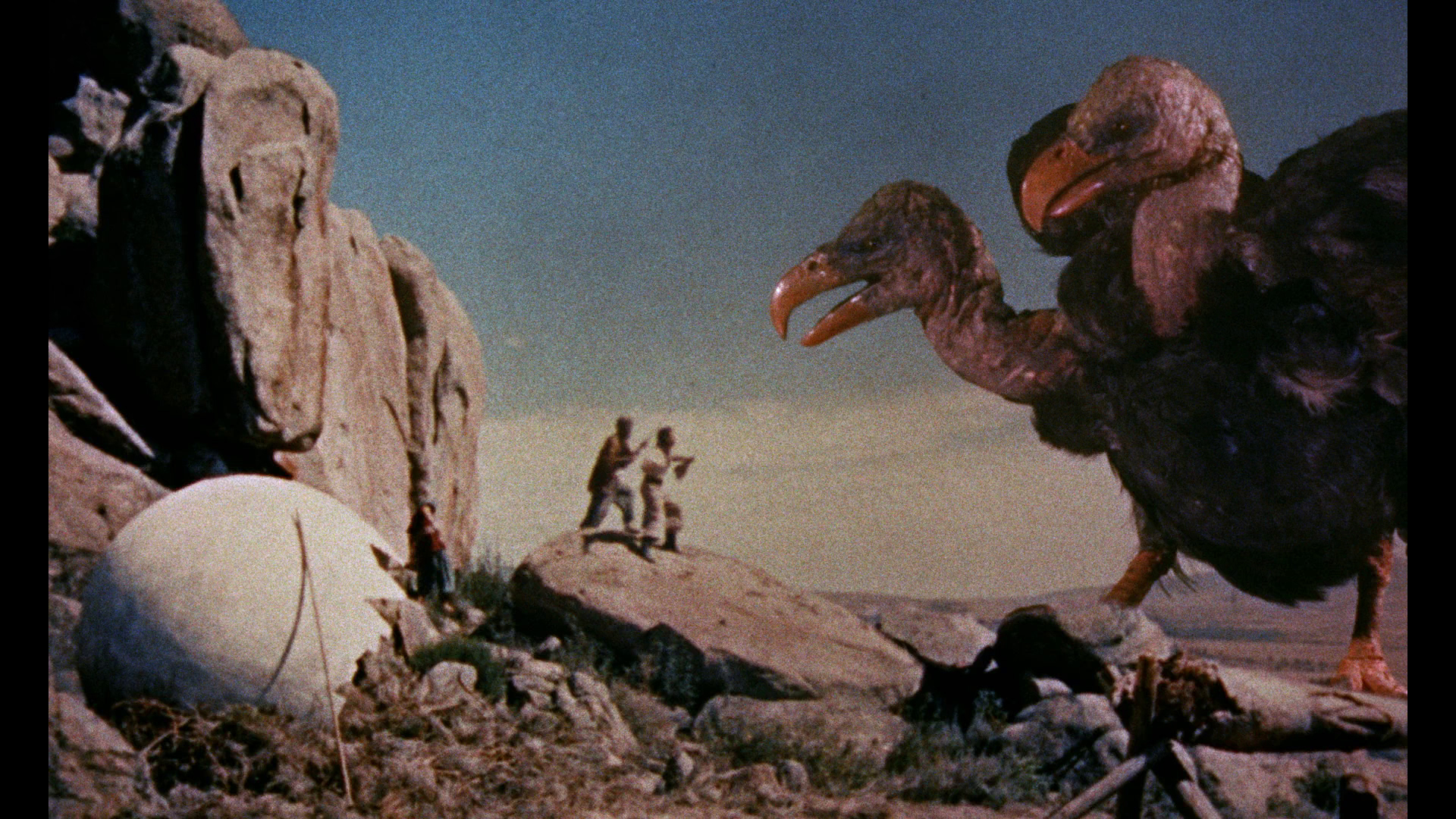 men embark on an adventure to retrieve the Roc egg, save the princess, defeat the magician, and deal with any monsters they
men embark on an adventure to retrieve the Roc egg, save the princess, defeat the magician, and deal with any monsters they 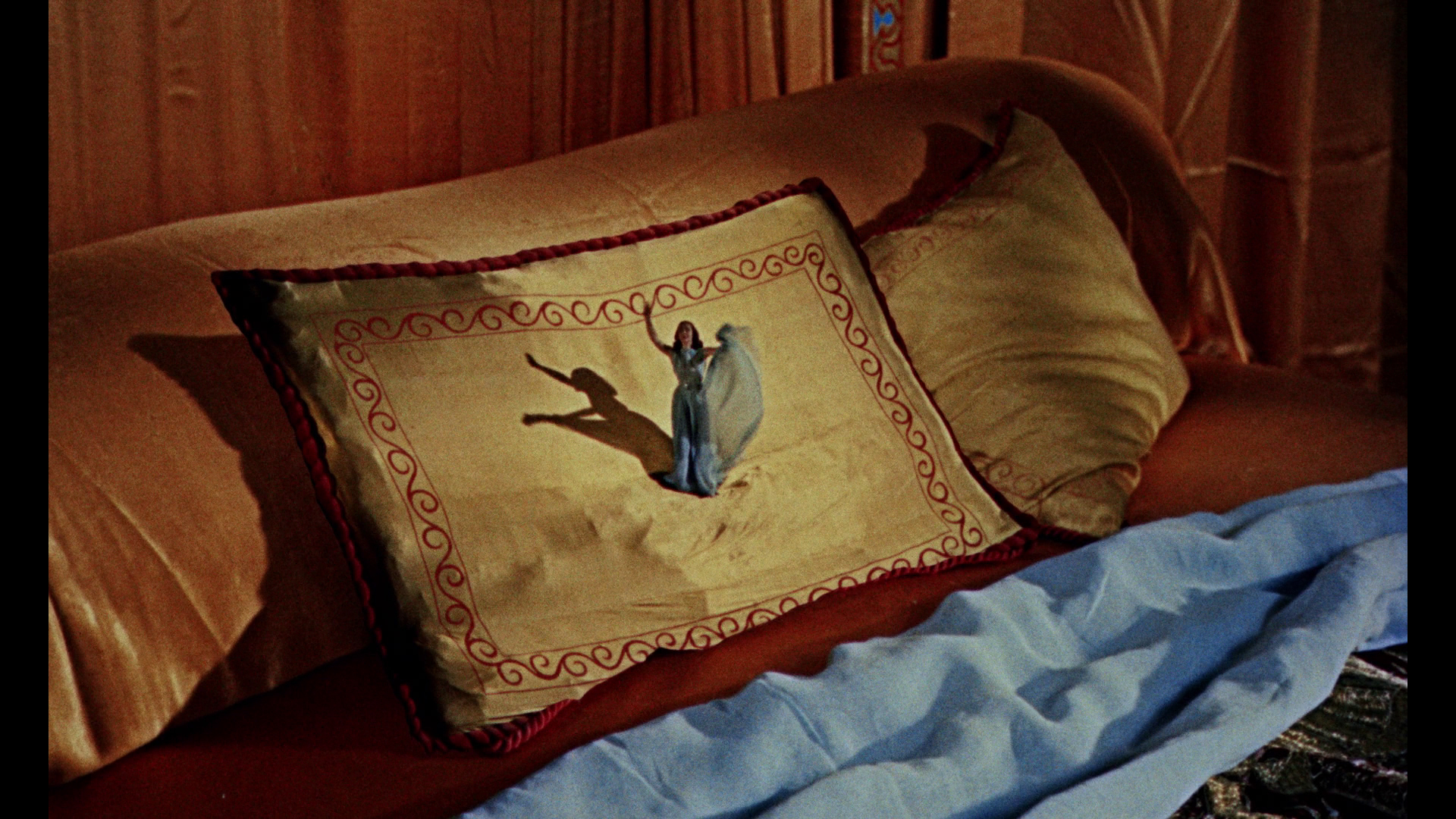 may encounter on the way.
may encounter on the way.  allowed plenty of breathing room, but this edition looks very tight. The mono audio is fine and clear throughout (oddly, the alternate Portuguese track contains a completely different main title cue) but seems lower quality than the robust stereo track prepared for the Pioneer Special Edition on laserdisc and Columbia's subsequent Sinbad box set. In the extras department, that DVD featured "This Is Dynamation," a 3-minute featurette produced to plug the release of Sinbad, while an 11-minute television interview with Harryhausen and the John Landis interview from the DVD of Jason and the Argonauts disc are included for more recent examinations of Harryhausen's craft. The Leonard Nimoy-narrated TV special "The Harryhausen Chronicles" (57m56s), a treasure trove of creature feature tidbits, examines all of Harryhausen's big screen work and includes some peeks at the various time-consuming technical processes used to bring his models to life. A large helping trailers ranging from 3 Worlds of Gulliver to The Golden Voyage of Sinbad rounds it out.
allowed plenty of breathing room, but this edition looks very tight. The mono audio is fine and clear throughout (oddly, the alternate Portuguese track contains a completely different main title cue) but seems lower quality than the robust stereo track prepared for the Pioneer Special Edition on laserdisc and Columbia's subsequent Sinbad box set. In the extras department, that DVD featured "This Is Dynamation," a 3-minute featurette produced to plug the release of Sinbad, while an 11-minute television interview with Harryhausen and the John Landis interview from the DVD of Jason and the Argonauts disc are included for more recent examinations of Harryhausen's craft. The Leonard Nimoy-narrated TV special "The Harryhausen Chronicles" (57m56s), a treasure trove of creature feature tidbits, examines all of Harryhausen's big screen work and includes some peeks at the various time-consuming technical processes used to bring his models to life. A large helping trailers ranging from 3 Worlds of Gulliver to The Golden Voyage of Sinbad rounds it out.  Sony brought the film to Blu-ray in 2003 as a standalone release and as part of a three-film Harryhausen set, thankfully opening the framing up to 1.66:1 and featuring a Dolby TrueHD 5.1 mix, Dolby Digital 2.0 stereo, and French and Thai tracks, with optional English (standard or SDH), French, Spanish, Indonesian, Mandarin, Thai, or Korean subtitles. The big extra here is an audio commentary with Harryhausen, visual effects artists Phil Tippet and Randall William Cook, author Steven Smith, and Arnold Kunert, covering the innovative effects in tremendous detail with notes about the trial and error process and the extreme amount of time
Sony brought the film to Blu-ray in 2003 as a standalone release and as part of a three-film Harryhausen set, thankfully opening the framing up to 1.66:1 and featuring a Dolby TrueHD 5.1 mix, Dolby Digital 2.0 stereo, and French and Thai tracks, with optional English (standard or SDH), French, Spanish, Indonesian, Mandarin, Thai, or Korean subtitles. The big extra here is an audio commentary with Harryhausen, visual effects artists Phil Tippet and Randall William Cook, author Steven Smith, and Arnold Kunert, covering the innovative effects in tremendous detail with notes about the trial and error process and the extreme amount of time 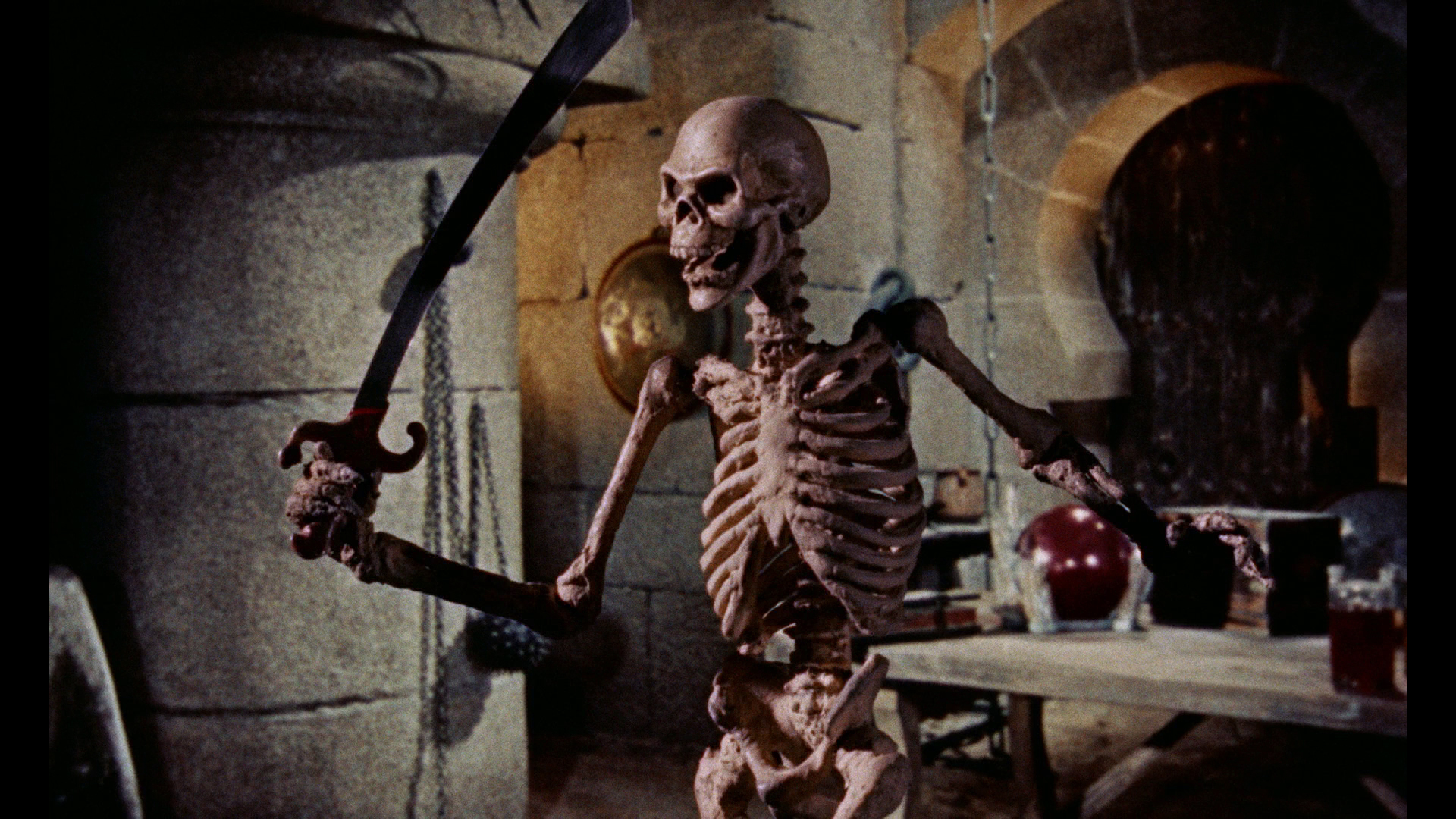 devoted to bringing the non-human characters to life. "Remembering the 7th Voyage of Sinbad" returns Harryhausen in front of the camera for a 23m31s exploration of the film's creation in less detail, while "The Harryhausen Legacy" (25m32s) offers an appreciation of the maestro's craft with admirers like archivist Bob Burns, directors John Landis, Frank Darabont, and Joe Dante, visual effects artists John Dykstra, Dennis Muren, Stan Winston, Tippett, Ken Ralston, the Chiodo Brothers and Hoyt Yeatman, makeup legend Rick Baker, and several more expounding on their favorite moments and the impact the films had on their craft. "The Music of Bernard Herrmann" (26m52s) features biographer Steve Smith summarizing the famed composer's impact on fantasy filmmaking with his thunderous score here and some of his other fantastic cinema scores including 3 Worlds of Gulliver, also with Harryhausen. "A Look Behind the Voyage" (11m52) is a vintage TV featurette with Harryhausen and Mathews recalling the film's shoot in Granada and the groundbreaking work they achieved with their opulent fantasy classic. An odd 1957 45 single created to promote the film called "Sinbad May Have Been Bad, but He's Been Good to Me" (2m34s) is a fun little lounge number (thankfully never included in the actual film!), a brief vintage "This Is Dynamation" promo touts Harryhausen's process (and has been included on several home video releases of his films), Landis returns for a more general 12-minute chat with Harryhausen about the golden age of fantasy films, and a gallery covers an assortment of lobby cards and posters. Bizarrely, the HD transfer on the Blu-ray is one of two commissioned by Sony, with a completely different one appearing on the now-defunct Monsters HD channel
devoted to bringing the non-human characters to life. "Remembering the 7th Voyage of Sinbad" returns Harryhausen in front of the camera for a 23m31s exploration of the film's creation in less detail, while "The Harryhausen Legacy" (25m32s) offers an appreciation of the maestro's craft with admirers like archivist Bob Burns, directors John Landis, Frank Darabont, and Joe Dante, visual effects artists John Dykstra, Dennis Muren, Stan Winston, Tippett, Ken Ralston, the Chiodo Brothers and Hoyt Yeatman, makeup legend Rick Baker, and several more expounding on their favorite moments and the impact the films had on their craft. "The Music of Bernard Herrmann" (26m52s) features biographer Steve Smith summarizing the famed composer's impact on fantasy filmmaking with his thunderous score here and some of his other fantastic cinema scores including 3 Worlds of Gulliver, also with Harryhausen. "A Look Behind the Voyage" (11m52) is a vintage TV featurette with Harryhausen and Mathews recalling the film's shoot in Granada and the groundbreaking work they achieved with their opulent fantasy classic. An odd 1957 45 single created to promote the film called "Sinbad May Have Been Bad, but He's Been Good to Me" (2m34s) is a fun little lounge number (thankfully never included in the actual film!), a brief vintage "This Is Dynamation" promo touts Harryhausen's process (and has been included on several home video releases of his films), Landis returns for a more general 12-minute chat with Harryhausen about the golden age of fantasy films, and a gallery covers an assortment of lobby cards and posters. Bizarrely, the HD transfer on the Blu-ray is one of two commissioned by Sony, with a completely different one appearing on the now-defunct Monsters HD channel 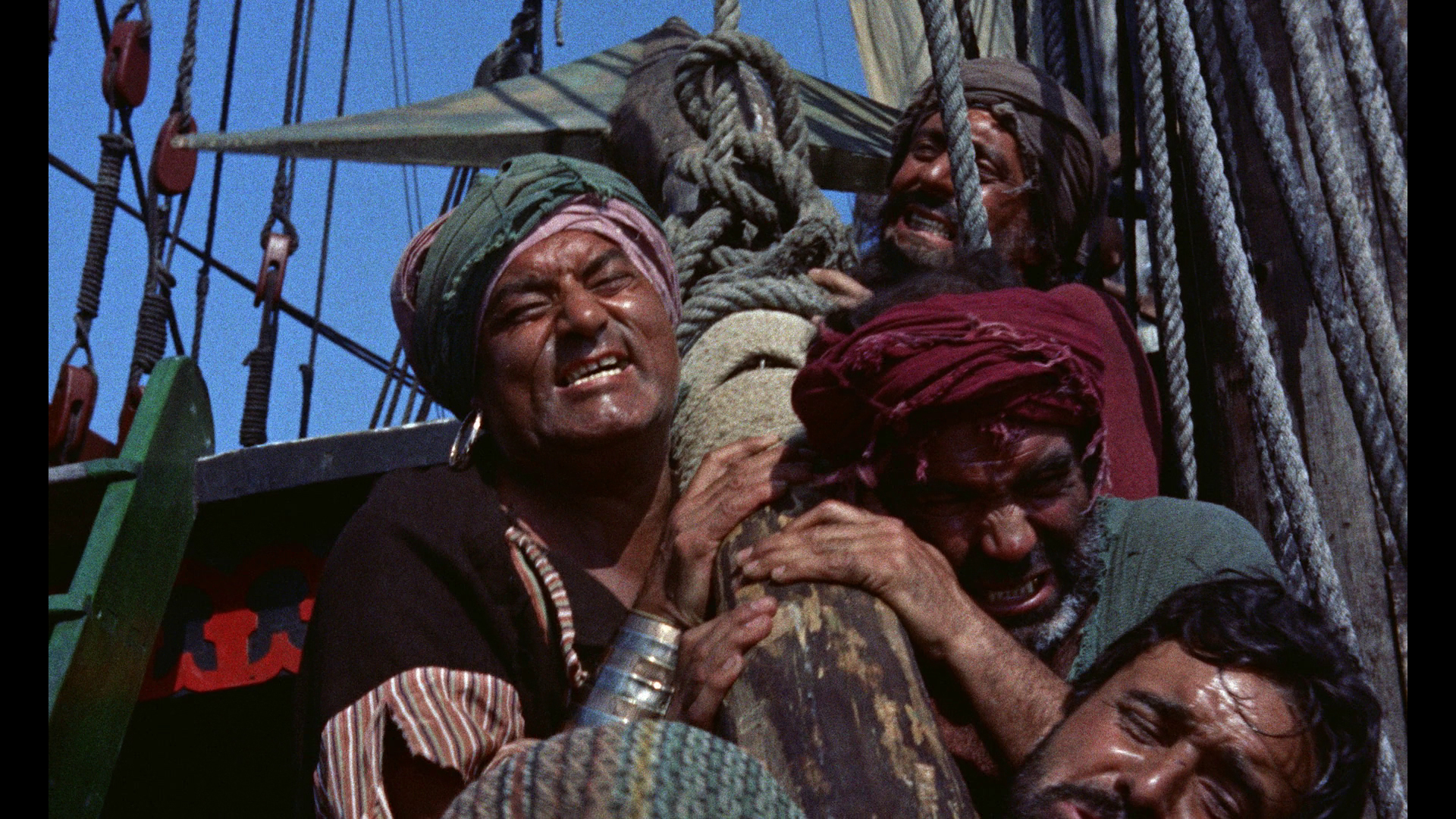 (which was 1.85:1 but featured stronger colors and detail); it still looks good here but left quite a bit of room for improvement.
(which was 1.85:1 but featured stronger colors and detail); it still looks good here but left quite a bit of room for improvement.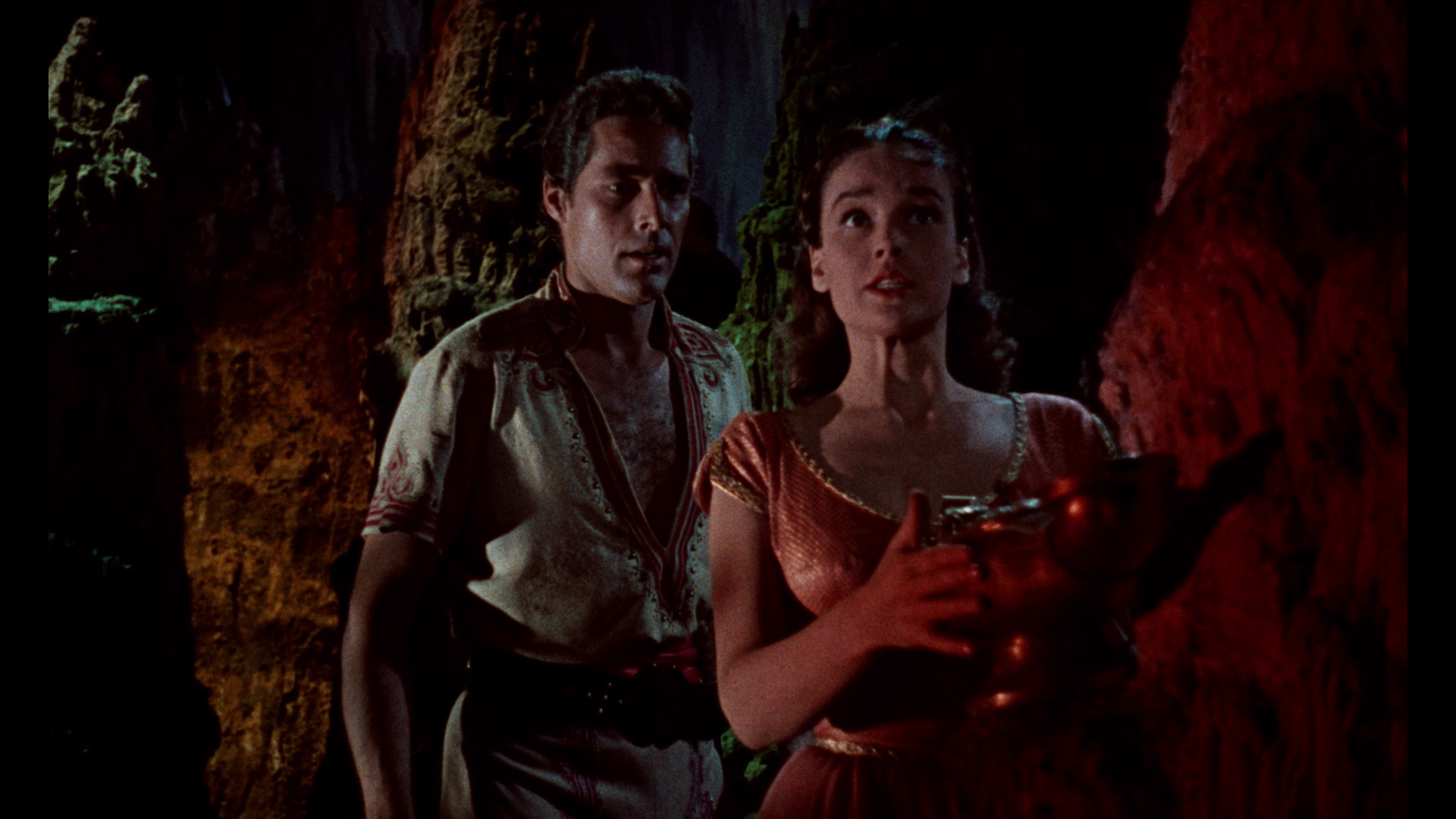
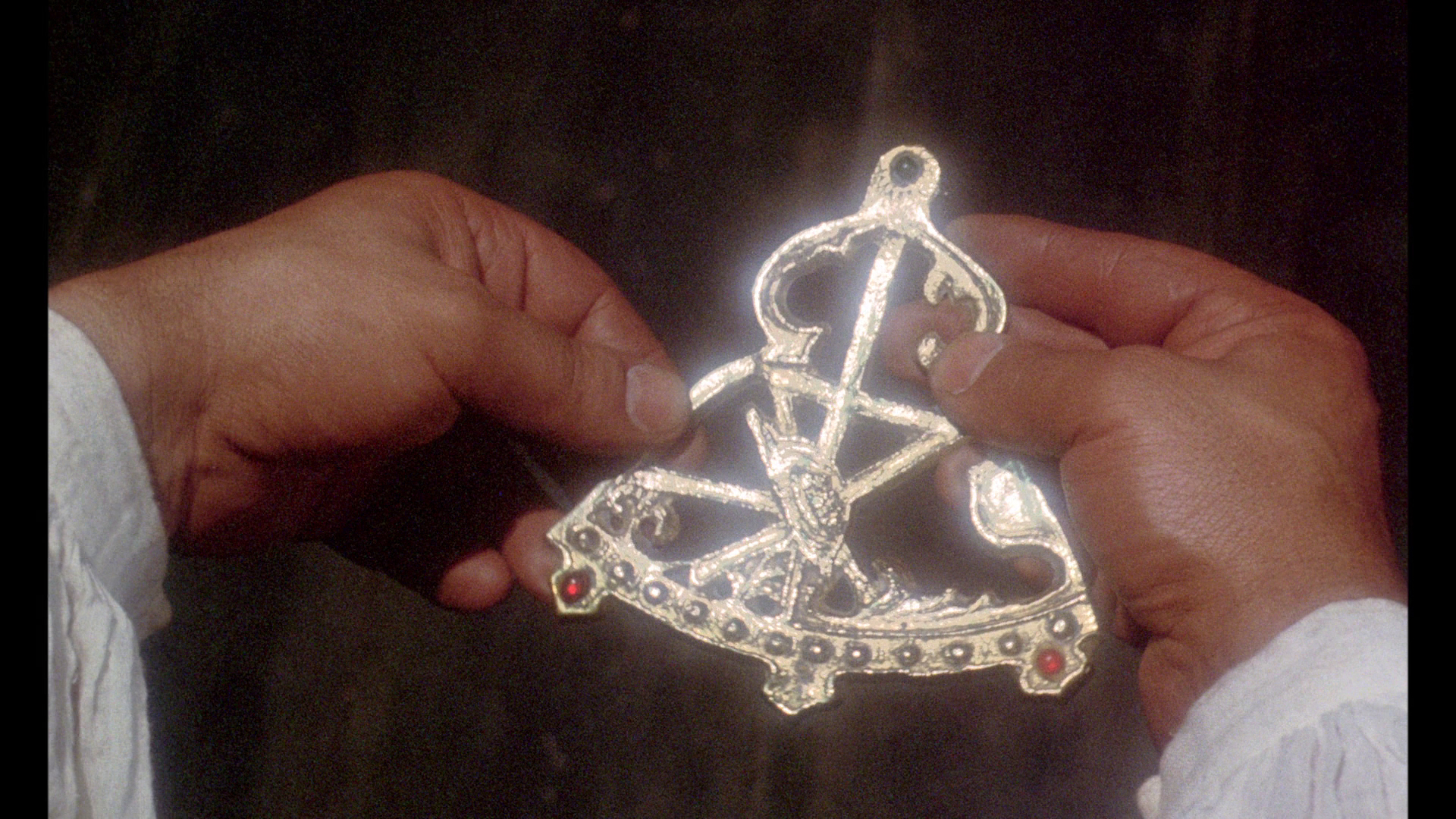
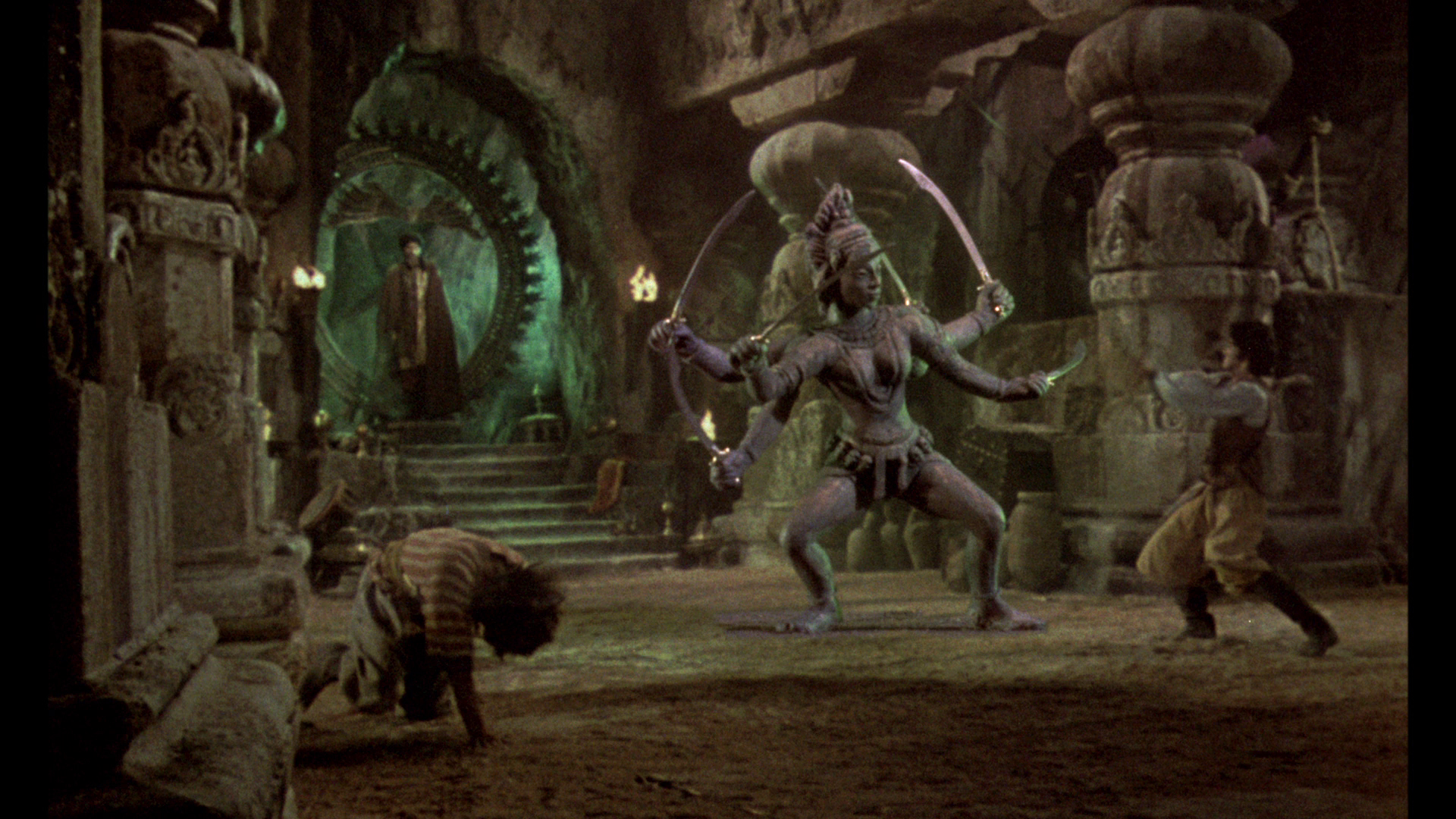 Fifteen years after the release of 7th Voyage, an entire generation of effects artists had been inspired to take Harryhausen's ideas to a new level in both studio and indie films. Harryhausen decided to revisit his most popular hero with a brand-new production, The Golden Voyage of Sinbad, which began the tradition of using a different director, star, and composer for each film in what would become a trilogy. (It also started the unofficial trend of baring as much female skin as possible within the then-lenient confines of a G rating.) John Phillip Law (Barbarella, Danger: Diabolik) grew out a beard and sported an earring as the adventurous sailor, who retrieves a golden ornament from a flying homunculus during an ocean expedition. The discovery's supernatural connections are immediately obvious when Sinbad decides to wear the sparkly gold treasure as a necklace into town and discovers it's tied to a nefarious sorcerer, Prince Koura (Baker, fresh off of Nicholas and Alexandra and The Canterbury Tales and a future Doctor Who based on his role here), who wants it back for his sinister plans. Sinbad and his men end up visiting the island of Isor to see a gold-masked oracle capable of unlocking the mystery, only to be taken prisoner instead and forced into battle with a giant centaur. Also involved is a Vizier (Wilmer) who possesses the other half of the ornament, which is actually a mystical map, and a slave girl named Margiana (legendary scream queen Munro) with an eye tattoo on her palm
Fifteen years after the release of 7th Voyage, an entire generation of effects artists had been inspired to take Harryhausen's ideas to a new level in both studio and indie films. Harryhausen decided to revisit his most popular hero with a brand-new production, The Golden Voyage of Sinbad, which began the tradition of using a different director, star, and composer for each film in what would become a trilogy. (It also started the unofficial trend of baring as much female skin as possible within the then-lenient confines of a G rating.) John Phillip Law (Barbarella, Danger: Diabolik) grew out a beard and sported an earring as the adventurous sailor, who retrieves a golden ornament from a flying homunculus during an ocean expedition. The discovery's supernatural connections are immediately obvious when Sinbad decides to wear the sparkly gold treasure as a necklace into town and discovers it's tied to a nefarious sorcerer, Prince Koura (Baker, fresh off of Nicholas and Alexandra and The Canterbury Tales and a future Doctor Who based on his role here), who wants it back for his sinister plans. Sinbad and his men end up visiting the island of Isor to see a gold-masked oracle capable of unlocking the mystery, only to be taken prisoner instead and forced into battle with a giant centaur. Also involved is a Vizier (Wilmer) who possesses the other half of the ornament, which is actually a mystical map, and a slave girl named Margiana (legendary scream queen Munro) with an eye tattoo on her palm 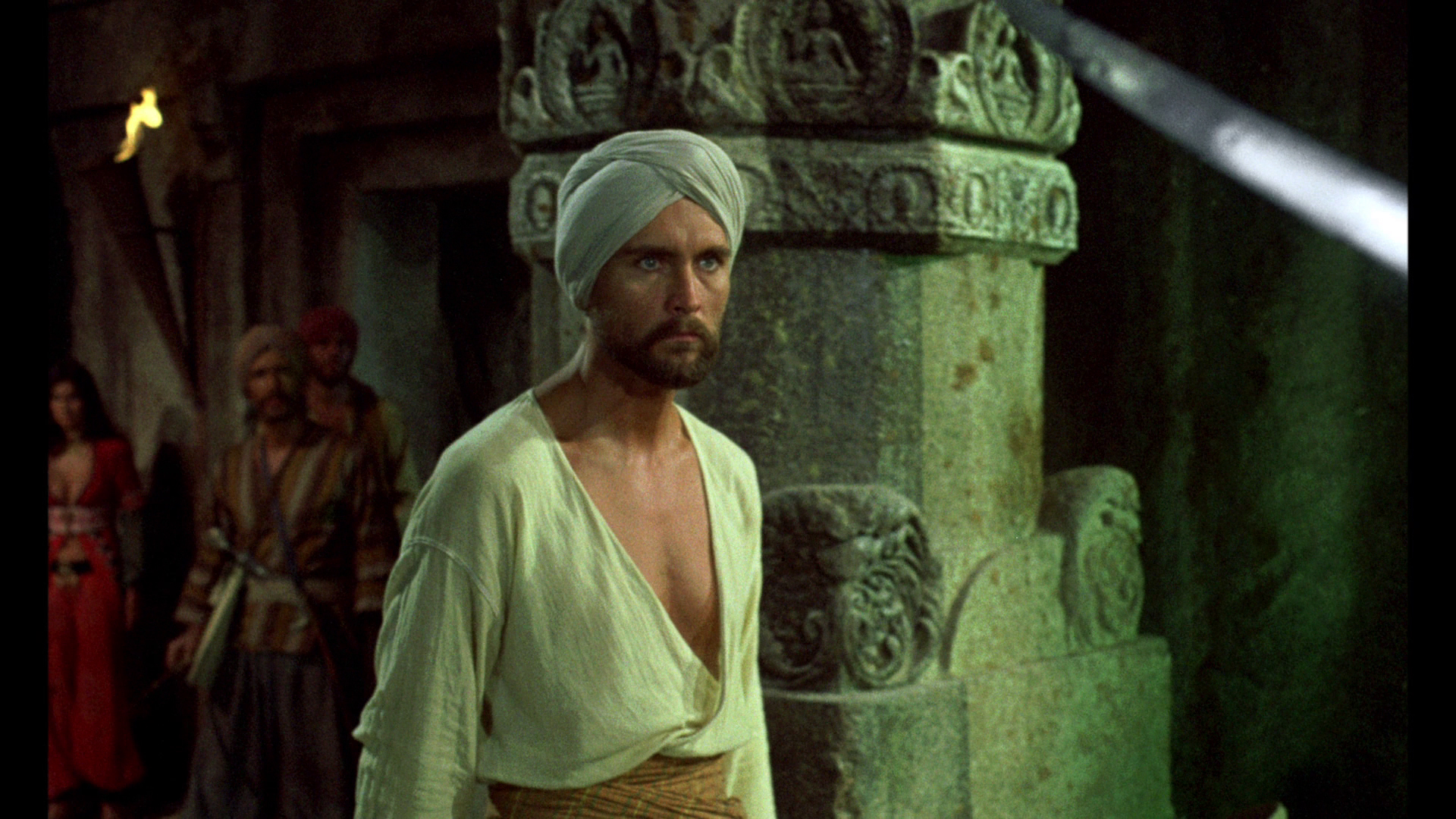 that proves valuable in their quest.
that proves valuable in their quest. 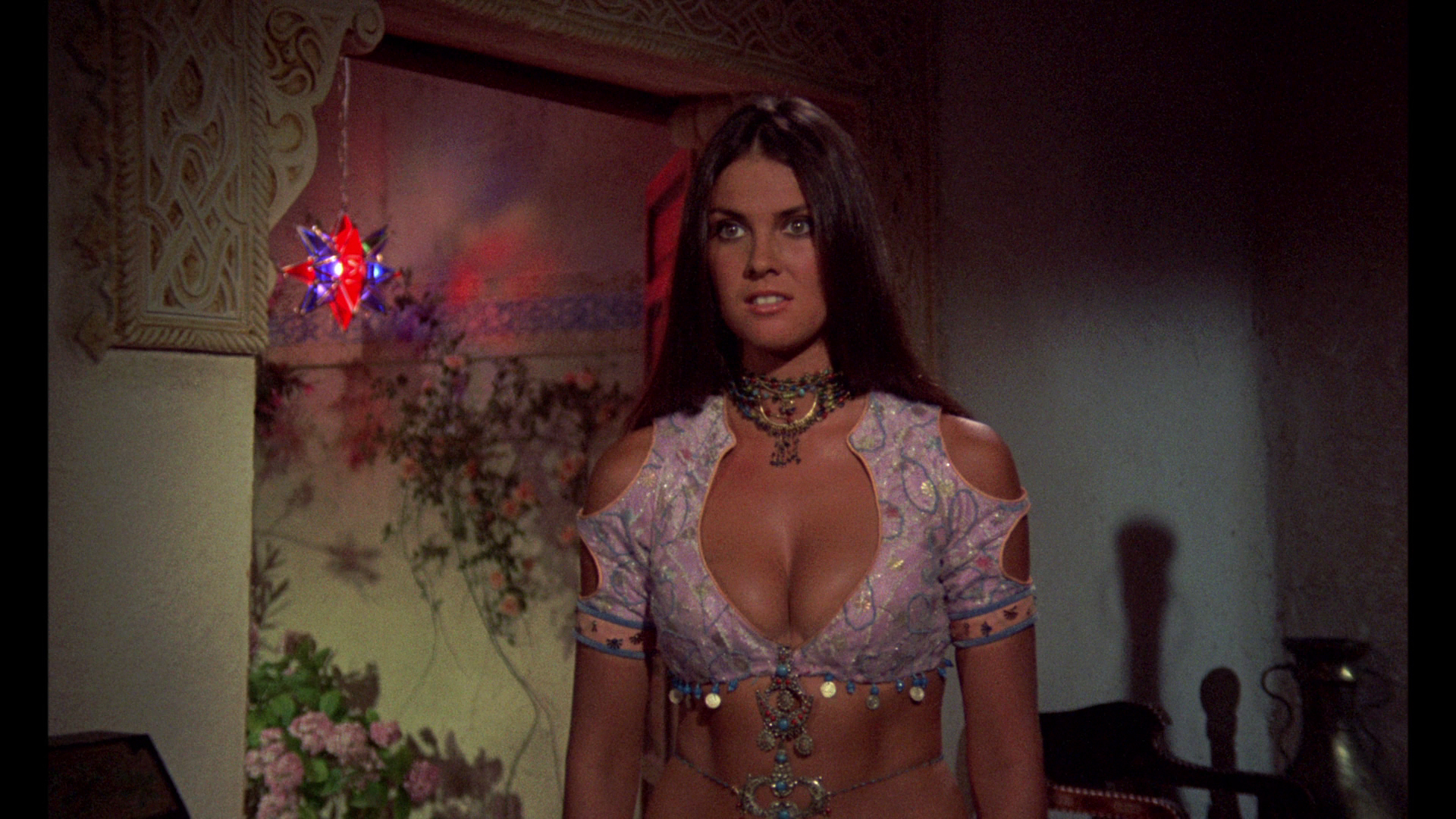
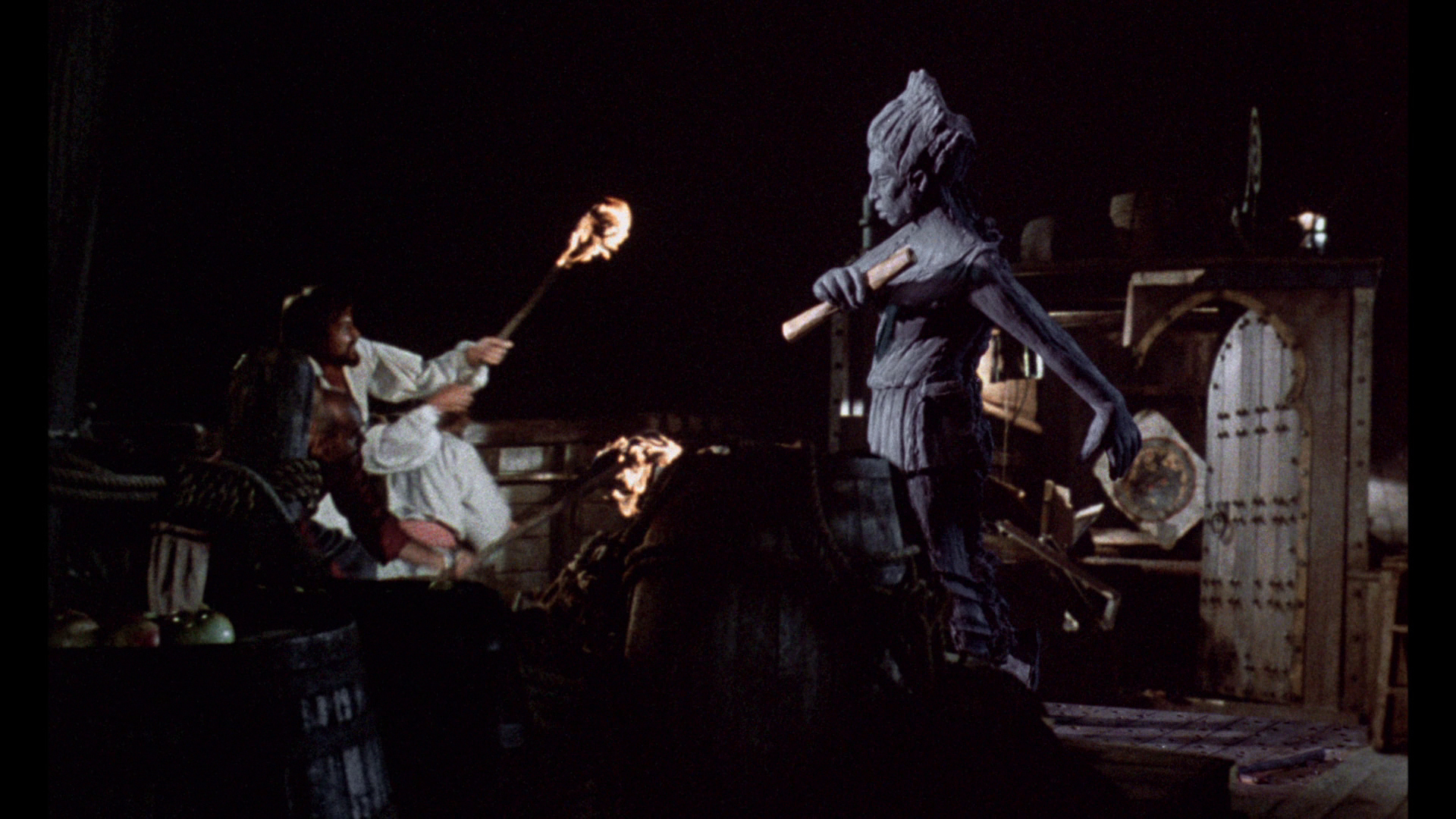 isolated score track, a DTS-HD MA 5.1 English track with optional English SDH subtitles (no original mono), the theatrical trailer, and unrelated featurettes about Mysterious Island, 3 Worlds of Gulliver, and Earth vs. the Flying Saucers. The Sony-provided transfer from a 2K restoration is a real
isolated score track, a DTS-HD MA 5.1 English track with optional English SDH subtitles (no original mono), the theatrical trailer, and unrelated featurettes about Mysterious Island, 3 Worlds of Gulliver, and Earth vs. the Flying Saucers. The Sony-provided transfer from a 2K restoration is a real 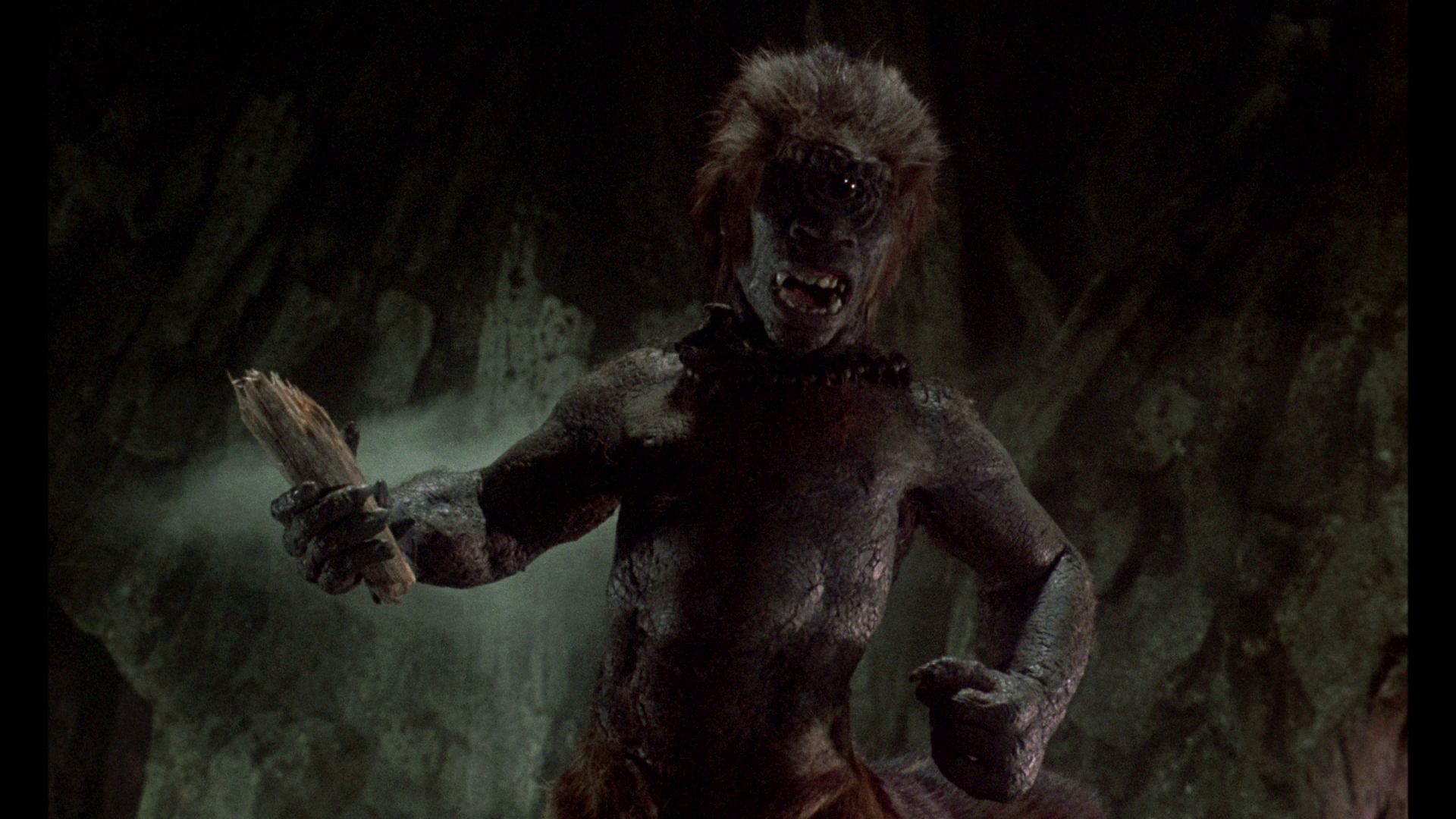 knockout with gorgeous colors, very vivid detail, and a rich sense of depth throughout. The Indicator release is from the same excellent source and looks very similar, albeit with an even higher bit rate that gives it a bit of an edge in motion. Audio options include the original mono track (LPCM), a DTS-HD MA 5.1 remix, an isolated score track (DTS-HD MA 2.0 stereo), with optional English SDH subtitles. Also included as an alternate track is a 90-minute 1970 audio interview with Harryhausen and producer Charles H. Schneer from the National Film Theatre in London. It's a very in-depth chat covering topics like the gradual decline of the star system, the level of violence acceptable in these films, the challenges of developing believable characters through Dynamation/Dynarama. The theatrical trailer is included along with an extensive sills and poster gallery, but there's a wealth of new video material here as well starting with a new Tom Baker interview, "Golden Years" (37m3s), which covers his career in fantastic cinema with a focus on this film including the other role he was originally intended to play, memories of the shoot in Spain, and the challenges of acting with swords, with thoughts on his theater work as well.
knockout with gorgeous colors, very vivid detail, and a rich sense of depth throughout. The Indicator release is from the same excellent source and looks very similar, albeit with an even higher bit rate that gives it a bit of an edge in motion. Audio options include the original mono track (LPCM), a DTS-HD MA 5.1 remix, an isolated score track (DTS-HD MA 2.0 stereo), with optional English SDH subtitles. Also included as an alternate track is a 90-minute 1970 audio interview with Harryhausen and producer Charles H. Schneer from the National Film Theatre in London. It's a very in-depth chat covering topics like the gradual decline of the star system, the level of violence acceptable in these films, the challenges of developing believable characters through Dynamation/Dynarama. The theatrical trailer is included along with an extensive sills and poster gallery, but there's a wealth of new video material here as well starting with a new Tom Baker interview, "Golden Years" (37m3s), which covers his career in fantastic cinema with a focus on this film including the other role he was originally intended to play, memories of the shoot in Spain, and the challenges of acting with swords, with thoughts on his theater work as well. 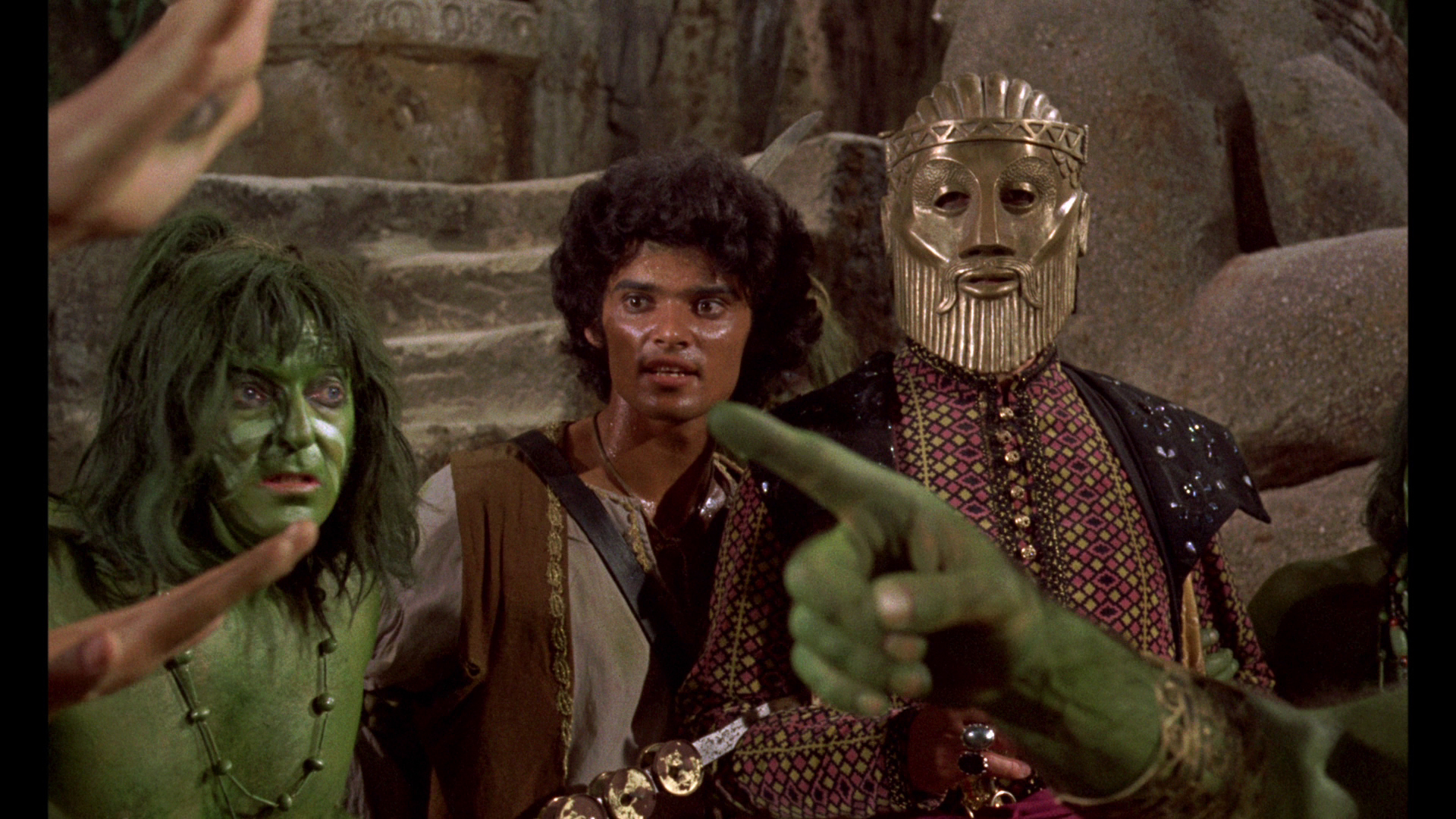 The wonderful Munro appears in "Golden Girl" (15m5s) offering her own perspective on how the film made expert use of the natural landscape and the wonder of watching Law and the stunt men doing the elaborate Kali battle. "The Harryhausen Legacy" is ported over here, and four different Super 8 versions of the feature ("Sinbad and the Oracle,"
The wonderful Munro appears in "Golden Girl" (15m5s) offering her own perspective on how the film made expert use of the natural landscape and the wonder of watching Law and the stunt men doing the elaborate Kali battle. "The Harryhausen Legacy" is ported over here, and four different Super 8 versions of the feature ("Sinbad and the Oracle," 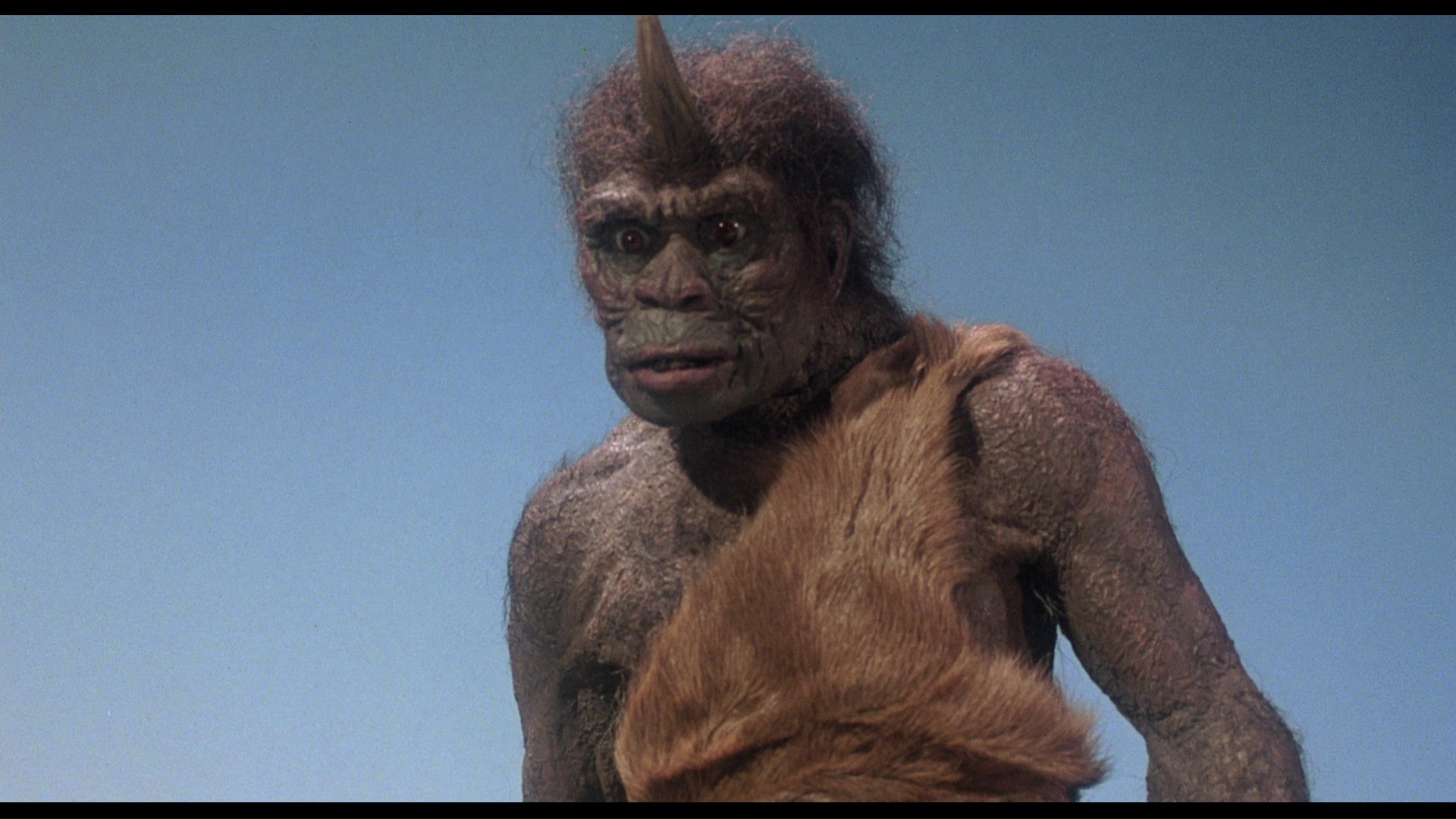 "Sinbad Battles the Monsters," "Sinbad Duels the Magic Sword," and "Sinbad Duels the Idol with Many Arms") focus on highlighting certain episodes rather than trying to cram the entire narrative into nearly eight minutes.
"Sinbad Battles the Monsters," "Sinbad Duels the Magic Sword," and "Sinbad Duels the Idol with Many Arms") focus on highlighting certain episodes rather than trying to cram the entire narrative into nearly eight minutes.  young Dione (Power, daughter of Tyrone), our intrepid heroes must head to a magical, polar wilderness where they hope to undo the evil spell that could plunge the kingdom into darkness.
young Dione (Power, daughter of Tyrone), our intrepid heroes must head to a magical, polar wilderness where they hope to undo the evil spell that could plunge the kingdom into darkness. 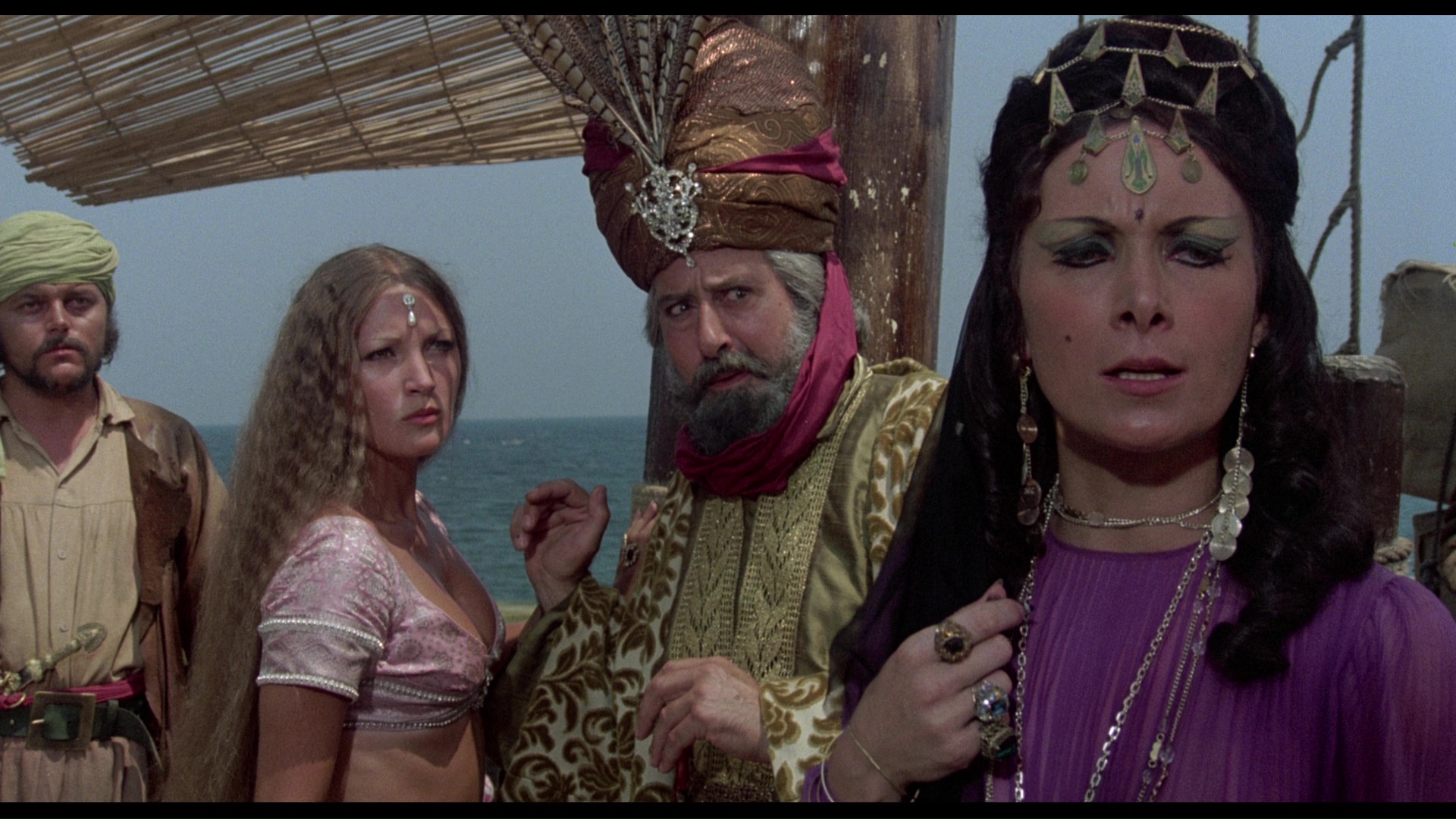
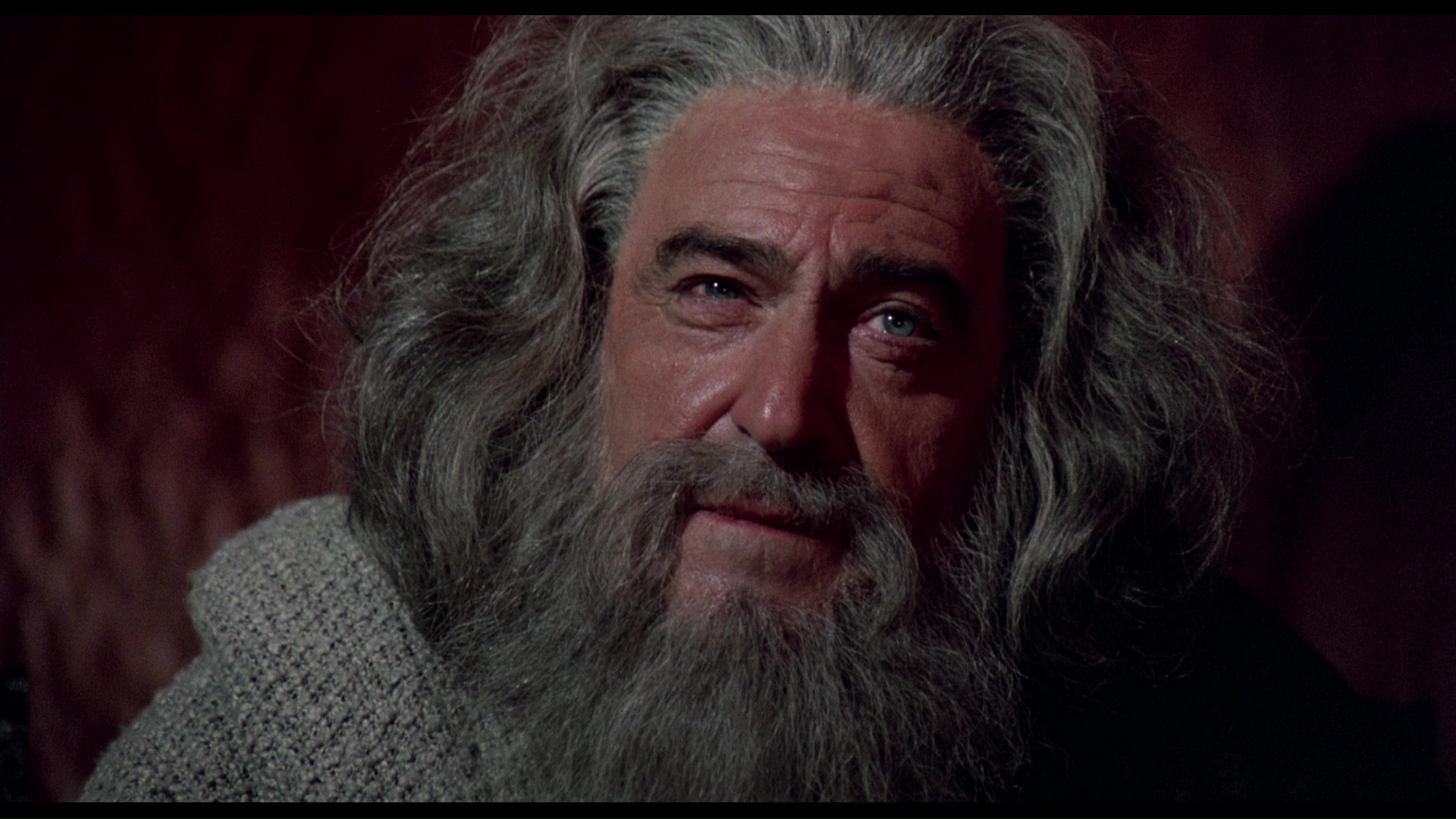 track for the music by Roy Budd (Get Carter, The Italian Job),
track for the music by Roy Budd (Get Carter, The Italian Job),  the"This Is Dynamation" featurette, and the theatrical trailer. Again the Indicator expands considerably in the extras department and features a sterling 2K-sourced transfer from Sony, which presents the film in the most immaculate quality possible as long as you take into account that there's more dirt and grit baked into the rear projection stop-motion footage than either of the previous two films. (Note: the first pressing featured a darker, more muted transfer compared to the Twilight Time, reportedly due to a different master delivered, but the more vibrant version is currently available as a repressed disc. Grabs in this review are from the second pressing. Anyone wishing to replace their current Blu-ray disc of SINBAD AND THE EYE OF THE TIGER should contact Powerhouse Films at info@powerhousefilms.co.uk providing proof of purchase and confirming the unique number of their limited set (as given on the rear of the bellband, 'xxxx/6,000').
the"This Is Dynamation" featurette, and the theatrical trailer. Again the Indicator expands considerably in the extras department and features a sterling 2K-sourced transfer from Sony, which presents the film in the most immaculate quality possible as long as you take into account that there's more dirt and grit baked into the rear projection stop-motion footage than either of the previous two films. (Note: the first pressing featured a darker, more muted transfer compared to the Twilight Time, reportedly due to a different master delivered, but the more vibrant version is currently available as a repressed disc. Grabs in this review are from the second pressing. Anyone wishing to replace their current Blu-ray disc of SINBAD AND THE EYE OF THE TIGER should contact Powerhouse Films at info@powerhousefilms.co.uk providing proof of purchase and confirming the unique number of their limited set (as given on the rear of the bellband, 'xxxx/6,000').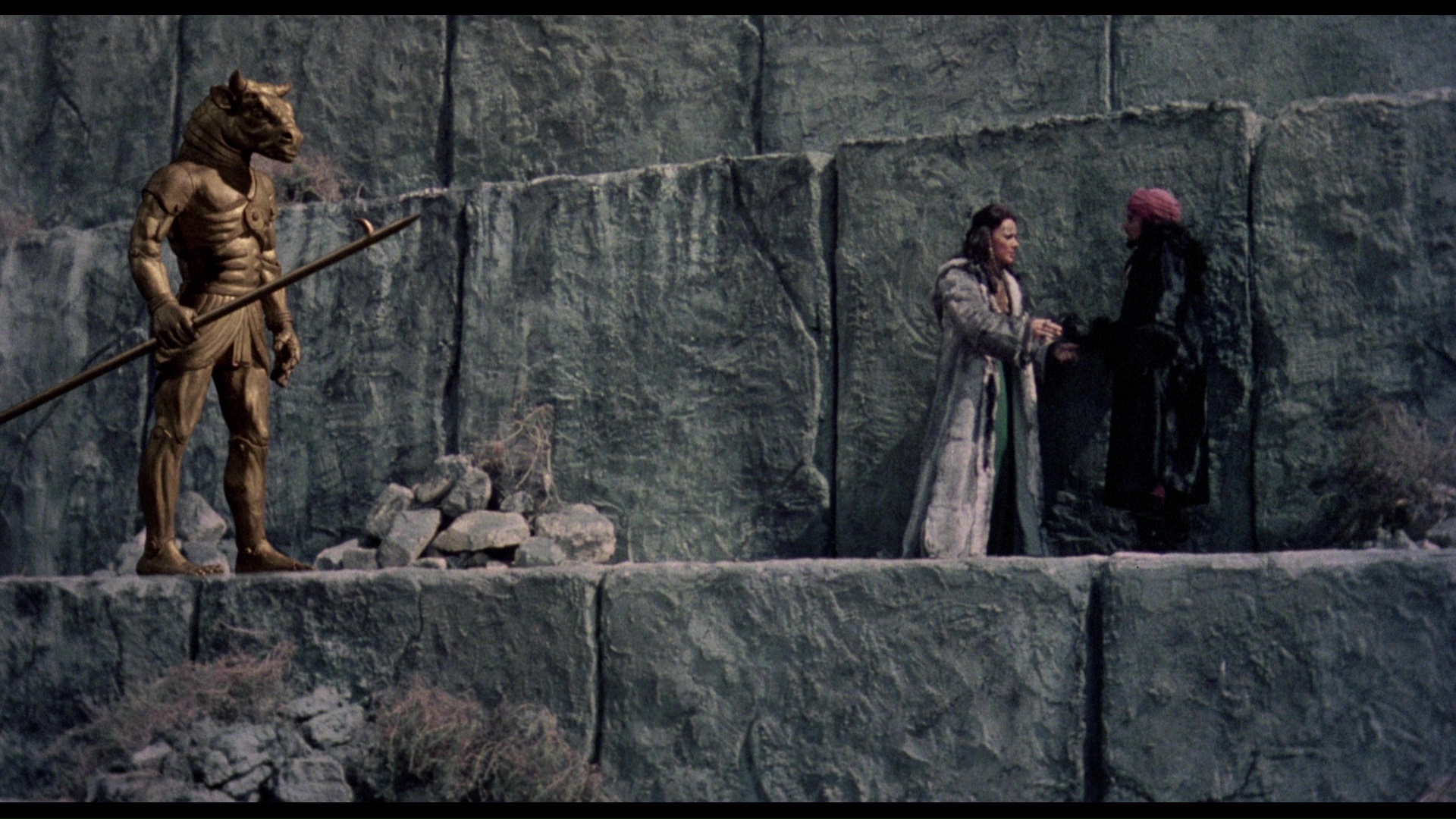 how she was hired just after Live and Let Die because of her "ethnic" appearance at the time
how she was hired just after Live and Let Die because of her "ethnic" appearance at the time 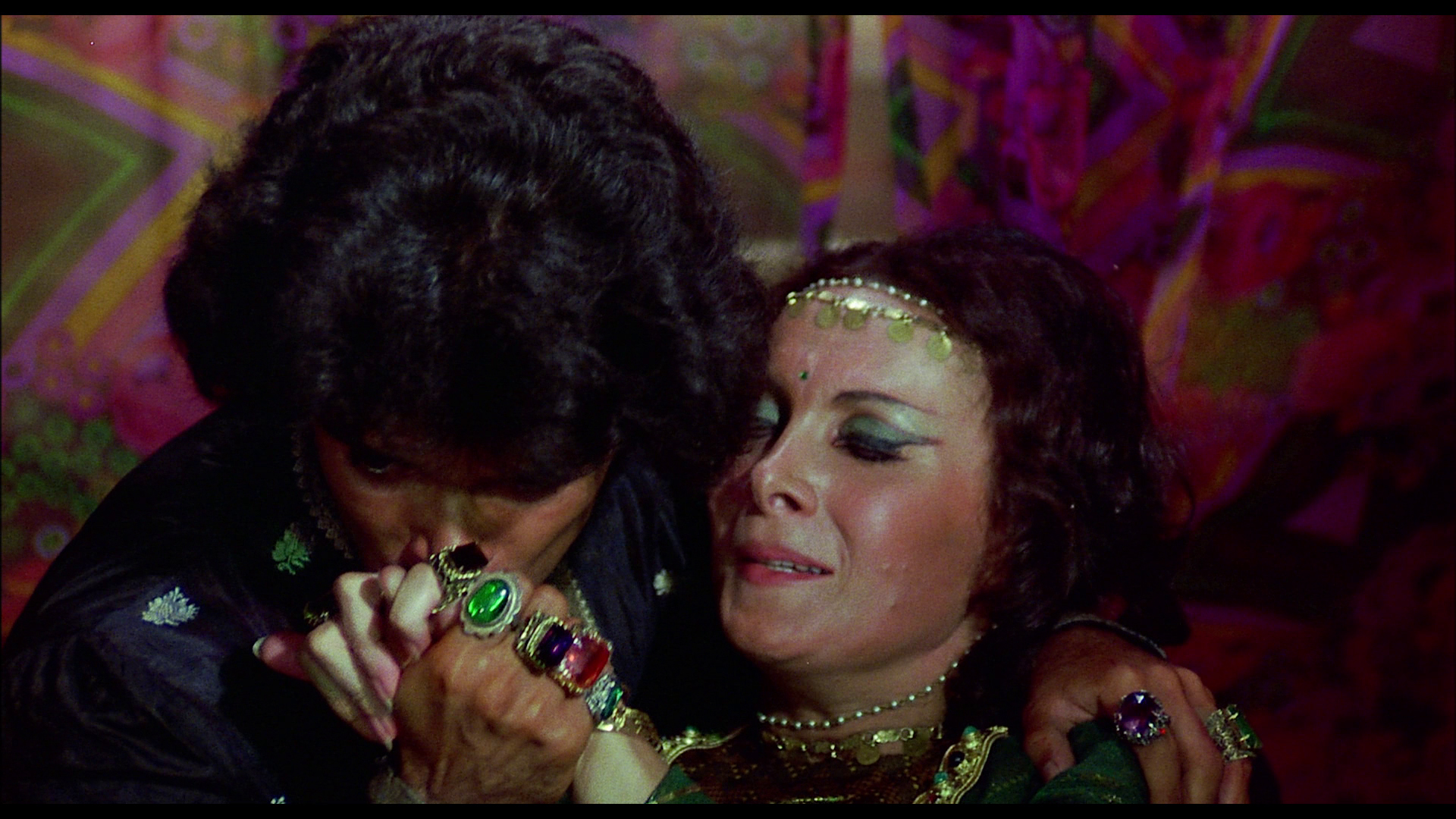 only to find her part chopped in half when Power came on board. Her stories about her costume, her nightmare hairstyle, and being in awe of Harryhausen's "secret" process (which forced her to imagine the monsters without any reference) are all worth hearing. Limited to 6,000 units, the box also includes a beautiful and much thicker than usual insert book featuring essays on each film by Michael Brooke, compiled oral histories with comments from the participants (including Harryhausen, Juran, Schneer, Mathews, Law, Munro, Wayne, and Budd), plus oral history looks at the unmade fourth film Sinbad Goes to Mars and a breakdown of the Dynamation process.
only to find her part chopped in half when Power came on board. Her stories about her costume, her nightmare hairstyle, and being in awe of Harryhausen's "secret" process (which forced her to imagine the monsters without any reference) are all worth hearing. Limited to 6,000 units, the box also includes a beautiful and much thicker than usual insert book featuring essays on each film by Michael Brooke, compiled oral histories with comments from the participants (including Harryhausen, Juran, Schneer, Mathews, Law, Munro, Wayne, and Budd), plus oral history looks at the unmade fourth film Sinbad Goes to Mars and a breakdown of the Dynamation process.